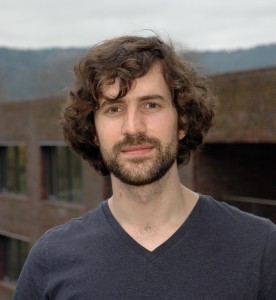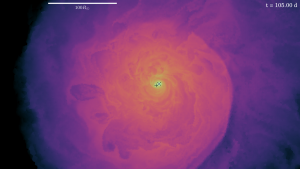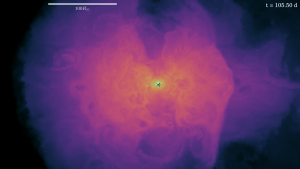Turbulent times: When stars approach
HITS astrophysicists use new methods to simulate the common-envelope phase of binary stars, discovering dynamic irregularities that may help to explain how supernovae evolve.
When we look at the night sky, we see stars as tiny points of light eking out a solitary existence at immense distances from Earth. But appearances are deceptive. More than half the stars we know of have a companion, a second nearby star that can have a major impact on their primary companions. The interplay within these so-called binary star systems is particularly intensive when the two stars involved are going through a phase in which they are surrounded by a common envelope consisting of hydrogen and helium. Compared to the overall time taken by stars to evolve, this phase is extremely short, so astronomers have great difficulty observing and hence understanding it. This is where theoretical models with highly compute-intensive simulations come in. Research into this phenomenon is relevant understanding a number of stellar events such as supernovae.
Using new methods, astrophysicists Sebastian Ohlmann, Friedrich Röpke, Rüdiger Pakmor, and Volker Springel of the Heidelberg Institute for Theoretical Studies (HITS) have now made a step forward in modeling this phenomenon. As they report in The Astrophysical Journal Letters, the scientists have successfully used simulations to discover dynamic irregularities that occur during the common-envelope phase and are crucial for the subsequent existence of binary star systems. These so-called instabilities change the flow of matter inside the envelope, thus influencing the stars’ distance from one another and determining, for example, whether a supernova will ensue and, if so, what kind it will be. The article is the fruit of collaboration between two HITS research groups, the Physics of Stellar Objects (PSO) group and the Theoretical Astrophysics group (TAP). Prof. Volker Springel’s AREPO code for hydrodynamic simulations was used and adapted for the modeling. It solves the equations on a moving mesh that follows the mass flow, and thus enhances the accuracy of the model.
Two stars, one envelope
More than half the stars we know of have evolved in binary star systems. The energy for their luminosity comes from the nuclear fusion of hydrogen at the core of the stars. As soon as the hydrogen fueling the nuclear fusion is exhausted in the heavier of the two stars, the star core shrinks. At the same time, a highly extended stellar envelope evolves, consisting of hydrogen and helium. The star becomes a red giant.
As the envelope of the red giant goes on expanding, the companion star draws the envelope to itself via gravity, and part of the envelope flows towards it. In the course of this process the two stars come closer to one another. Finally, the companion star may fall into the envelope of the red giant and both stars are then surrounded by a common envelope. As the core of the red giant and the companion draw closer together, the gravity between them releases energy that passes into the common envelope. As a result, the envelope is ejected and mixes with interstellar matter in the galaxy, leaving behind it a close binary star system consisting of the core of the giant and the companion star.
The path to stellar explosion
Sebastian Ohlmann of the PSO group explains why this common-envelope phase is important for our understanding of the way various star systems evolve: “Depending on what the system of the common envelope looks like initially, very different phenomena may ensue in the aftermath, such as thermonuclear supernovae.” Ohlmann and colleagues are investigating the run-up to these stellar explosions, which are among the most luminous events in the universe and can light up a whole galaxy. But modeling the systems that can lead to such explosions is bedeviled by major uncertainty in the description of the common-envelope phase. One of the reasons for this is that the core of the giant is anything between a thousand and ten thousand times smaller than the envelope, so that spatial and temporal scale differences complicate the modeling process and make approximations necessary. The methodically innovative simulations performed by the Heidelberg scientists are a first step towards a better understanding of this phase.
Caption: Both images show slices through the three-dimensional simulation volume after 105 days in the common envelope. In the orbital plane (figure 1), the companion star and the red giant core are circling around each other. Image 2 shows a plane perpendicular to the orbital plane. (Images: Sebastian Ohlmann / HITS)
Publication:
Ohlmann, S. T., Röpke, F. K., Pakmor, R., & Springel, V. (2016):
Hydrodynamic moving-mesh simulations of the common envelope phase in binary stellar systems, The Astrophysical Journal Letters, 816, L9, DOI: 10.3847/2041-8205/816/1/L9
http://arxiv.org/abs/1512.04529
Astrophysics Data System:
http://adsabs.harvard.edu/abs/2016ApJ…
Press contact
Dr. Peter Saueressig
Head of Communications
HITS Heidelberg Institute for Theoretical Studies
phone: +49 6221 533245
fax: +49 6221 533298
peter.saueressig@h-its.org
Scientific contact
Sebastian Ohlmann
sebastian.ohlmann@h-its.org
Prof. Dr. Friedrich Röpke
friedrich.roepke@h-its.org
Physics of Stellar Objects group
HITS Heidelberg Institute for Theoretical Studies
phone: +49 6221 533270
fax: +49 6221 533298
https://www.h-its.org
About HITS
HITS, the Heidelberg Institute for Theoretical Studies, was established in 2010 by physicist and SAP co-founder Klaus Tschira (1940-2015) and the Klaus Tschira Foundation as a private, non-profit research institute. HITS conducts basic research in the natural, mathematical, and computer sciences. Major research directions include complex simulations across scales, making sense of data, and enabling science via computational research. Application areas range from molecular biology to astrophysics. An essential characteristic of the Institute is interdisciplinarity, implemented in numerous cross-group and cross-disciplinary projects. The base funding of HITS is provided by the Klaus Tschira Foundation.



